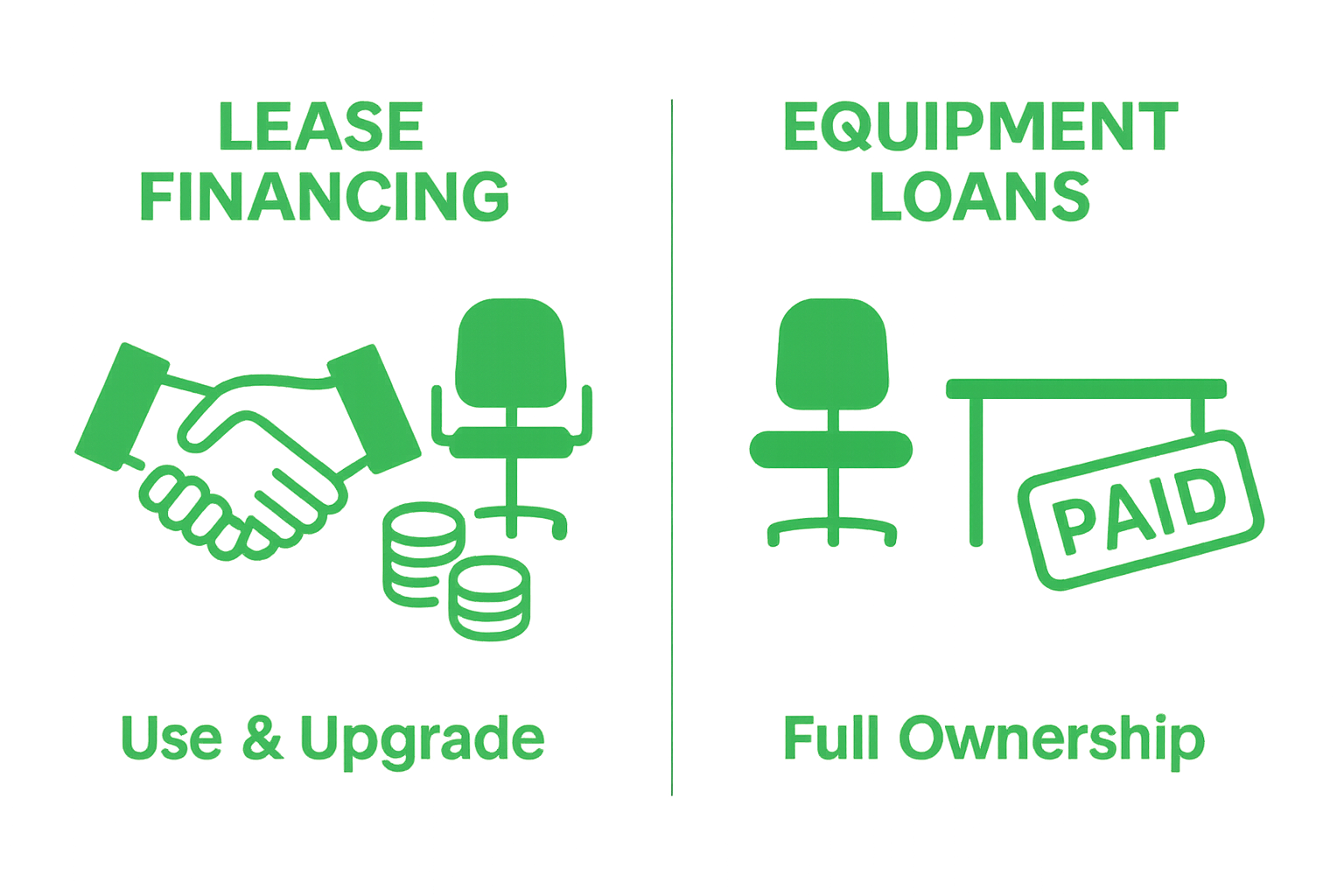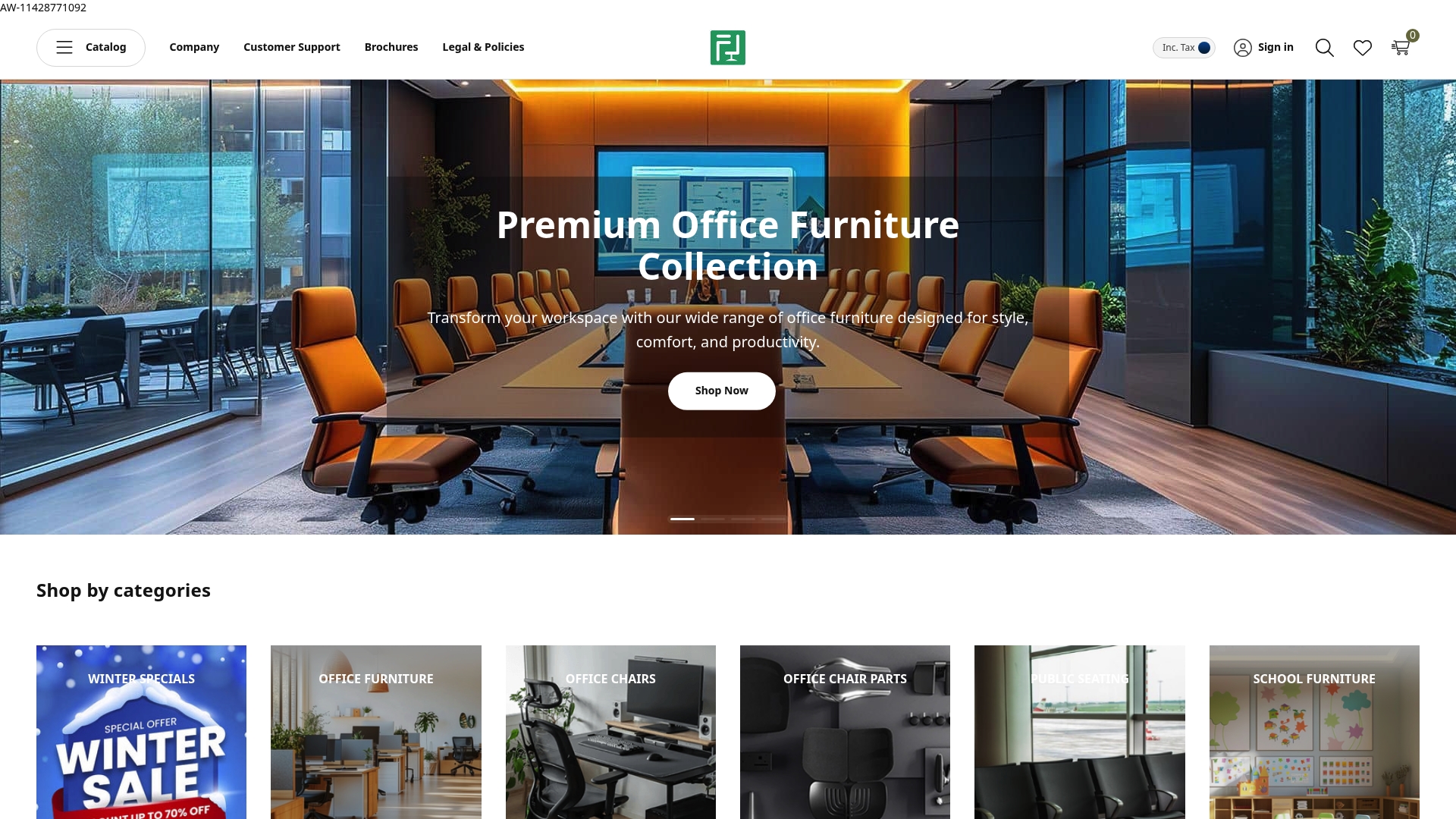Understanding Furniture Finance Options for Businesses
Sep 27, 2025
Understanding Furniture Finance Options for Businesses

Business owners in South Africa know how expensive setting up an office can get and furniture is often one of the priciest hurdles. Yet most people are shocked to discover that flexible financing options can cut upfront costs by over 70 percent compared to buying outright. What really catches people off guard is how these strategies do not just ease the budget but can actually help companies manage cash flow and grow faster than those paying in full.
Table of Contents
- What Are Furniture Finance Options And Their Types?
- Why Furniture Finance Matters For Businesses
- How Furniture Finance Options Work In Practice
- Key Concepts In Furniture Finance For Businesses
- Real-World Context And Examples Of Furniture Financing
Quick Summary
| Takeaway | Explanation |
|---|---|
| Consider lease financing for flexibility | Lease financing allows businesses to use furniture with lower upfront costs and flexible payments, ideal for managing cash flow. |
| Evaluate equipment loans for ownership | Equipment loans provide direct funding for purchasing furniture outright, resulting in full ownership once repaid. |
| Assess overall financing costs carefully | Understanding total costs, cash flow impact, and tax benefits is crucial in choosing the right furniture finance option. |
| Plan repayments to maintain financial stability | Structured payment mechanisms help companies predict monthly expenses, ensuring sustained financial health and growth potential. |
| Utilise furniture finance for workspace enhancement | Effective use of furniture finance supports modern designs, attracting talent and improving productivity without financial strain. |
What are Furniture Finance Options and Their Types?
Furniture finance options are specialized financial solutions designed to help businesses acquire furniture and equipment without requiring substantial upfront capital expenditure. These strategic financial mechanisms enable companies to spread the cost of furniture investments over time, preserving cash flow and allowing more flexible budget management.
Types of Furniture Finance Options
Businesses in South Africa have several furniture financing strategies available, each tailored to different operational needs and financial circumstances. Understanding these options can help organizations make informed decisions about their workplace investments.
This table summarises key considerations businesses should evaluate when selecting the most appropriate furniture finance option, aiding informed decision-making and long-term financial planning.
| Consideration | Description |
|---|---|
| Total Financing Cost | Assess both upfront and total payment outlay over the finance term |
| Cash Flow Impact | Evaluate effect of monthly payments on available working capital |
| Tax Implications | Identify any allowable tax deductions or benefits linked to finance options |
| Growth Plans | Consider flexibility for future expansion or upgrades |
| Payment Flexibility | Check if payment structures can adapt to seasonal or fluctuating revenue patterns |
| Asset Management | Decide on importance of eventual asset ownership versus ongoing access |
Lease Financing
Lease financing allows businesses to use furniture while making regular monthly payments without owning the asset immediately. Learn more about custom furniture solutions that can be integrated with leasing arrangements. Key characteristics of lease financing include:
- Flexible payment terms ranging from 12 to 60 months
- Lower initial capital requirement
- Potential tax advantages
- Option to upgrade furniture at lease end
Equipment Loans
Equipment loans provide businesses with direct funding to purchase furniture outright. These loans are secured against the furniture itself, offering more straightforward ownership transfer. Typical features include:

- Fixed interest rates
- Predetermined repayment schedules
- Full ownership transfer upon complete payment
- Potentially shorter financing periods
Considerations for Choosing Furniture Finance
When selecting a furniture finance option, businesses should evaluate multiple factors:
- Total cost of financing
- Impact on cash flow
- Potential tax implications
- Long-term business growth plans
- Flexibility of payment structures
By carefully assessing these financial strategies, South African businesses can make strategic decisions that support workspace development while maintaining financial stability.
The following table compares the main types of furniture finance options available to South African businesses, highlighting their core features, benefits, and considerations.
| Finance Option | Ownership | Payment Structure | Key Benefits | Main Considerations |
|---|---|---|---|---|
| Lease Financing | No (until lease end or upgrade option) | Regular monthly payments | Flexible terms, lower upfront cost, option to upgrade, possible tax advantages | No immediate asset ownership, end-of-term options may vary |
| Equipment Loan | Yes (after repayment) | Fixed instalments over set period | Ownership after payment, structured repayments, possible shorter term | Initial capital security, interest charges, asset depreciation |
| Hire Purchase | Gradual (transfers after all payments) | Regular payments over agreed term | Eventual ownership, predictable structure | Larger overall cost due to interest, maintenance responsibilities |
| Operating Lease | No (usage only) | Short-term regular payments | Off-balance-sheet, easy returns/refresh, risk of obsolescence is with lessor | No ownership, may be more costly long-term, return conditions apply |
| Conditional Sale | Contingent (upon full payment) | Installments towards acquisition | Potentially easier transfer of ownership, fits revenue cycles | Sometimes stricter terms, asset at risk if payment lapses |
Why Furniture Finance Matters for Businesses
Furniture finance represents a strategic financial approach that enables businesses to transform their workspace without compromising their economic stability. By providing flexible funding mechanisms, these financial solutions empower organizations to make critical infrastructure investments while maintaining robust financial health.
Economic Flexibility and Cash Flow Management
The primary significance of furniture finance lies in its ability to preserve working capital. Instead of allocating substantial lump-sum payments for furniture acquisitions, businesses can distribute expenses over manageable periods. Explore our budget-friendly office furniture guide to understand how strategic financing can optimize your workplace investments.
Key economic advantages include:
- Minimized immediate financial strain
- Preservation of liquid assets for core business operations
- Predictable monthly expenditure planning
- Enhanced budgetary control
Strategic Business Growth and Infrastructure Development
Furniture finance enables businesses to upgrade workplace environments without experiencing significant financial pressure. Modern workspaces directly correlate with employee productivity, professional image, and organizational performance. By spreading furniture investments across structured payment plans, companies can:
- Implement contemporary workspace designs
- Attract and retain top talent through enhanced work environments
- Maintain technological and aesthetic workplace standards
- Scale infrastructure alongside business growth
Risk Mitigation and Financial Planning
Financing options provide businesses with risk management strategies that traditional purchasing methods cannot offer. Research from the South African Reserve Bank highlights that flexible financing reduces economic volatility for small and medium enterprises.
Businesses benefit from:
- Predictable financial commitments
- Potential tax deduction opportunities
- Reduced obsolescence risks
- Enhanced financial planning capabilities
By understanding and leveraging furniture finance options, South African businesses can create adaptive, professional workspaces while maintaining financial resilience and strategic flexibility.
How Furniture Finance Options Work in Practice
Furniture finance transforms theoretical financial strategies into tangible business solutions by creating structured pathways for acquiring workplace infrastructure. These mechanisms translate complex financial principles into practical, accessible procurement methods that adapt to diverse business requirements.
Application and Approval Process
The practical implementation of furniture finance begins with a comprehensive assessment of a business’s financial standing and specific furniture requirements. Learn more about creating optimal workplace environments to complement your financing strategy. Financial institutions evaluate several critical factors during the application process:
- Business credit history and rating
- Current financial performance metrics
- Projected revenue and growth potential
- Specific furniture investment requirements
- Capacity for consistent monthly payments
Structured Payment Mechanisms
Once approved, furniture finance options provide businesses with multiple payment structures tailored to their unique financial capabilities. These mechanisms typically involve:
- Fixed monthly installments
- Predetermined financing periods
- Flexible interest rate configurations
- Option for early settlement
- Potential tax deductibility of financing expenses
Risk Assessment and Financial Safeguards
Financial institutions implement robust risk management protocols to protect both the lender and borrower. Research from the South African Reserve Bank indicates that comprehensive risk assessment frameworks ensure sustainable financing solutions.
Key risk mitigation strategies include:
- Comprehensive credit evaluations
- Collateral requirements
- Performance monitoring
- Adaptive repayment structures
- Transparent contractual agreements
By understanding these practical implementation mechanisms, businesses can strategically leverage furniture finance to optimize workspace development while maintaining financial stability and growth potential.
Key Concepts in Furniture Finance for Businesses
Furniture finance involves sophisticated financial mechanisms that extend beyond simple transactional processes. These strategic financial tools require a nuanced understanding of legal, economic, and operational considerations that shape modern business infrastructure investments.
Asset Ownership and Financial Structures
Understanding the fundamental distinctions between different furniture financing models is crucial for making informed business decisions. Explore custom office furniture considerations that impact financial planning and asset management strategies. Key ownership structures include:
- Lease Financing: Temporary usage rights without immediate ownership
- Hire Purchase: Gradual ownership transfer through structured payments
- Conditional Sale: Ownership contingent upon complete payment
- Operating Lease: Short-term usage with return option
Financial Risk and Mitigation Strategies
Businesses must comprehensively evaluate potential financial risks associated with furniture financing. Critical risk assessment components encompass multiple interconnected factors that determine long-term financial sustainability:
- Credit worthiness evaluation
- Interest rate fluctuation potential
- Depreciation rate of furniture assets
- Contractual flexibility
- Potential tax implications
Regulatory and Compliance Considerations
Research from the South African Reserve Bank emphasizes the importance of understanding regulatory frameworks governing asset-based financial agreements. Businesses must navigate complex legal landscapes that define furniture finance transactions:
- Compliance with national financial regulations
- Transparent contractual agreements
- Accurate financial reporting requirements
- Protection of both lender and borrower interests
- Alignment with accounting standards
By mastering these key conceptual frameworks, businesses can develop sophisticated furniture financing strategies that balance economic efficiency with strategic growth objectives.
Real-World Context and Examples of Furniture Financing
Furniture financing transcends theoretical concepts, manifesting in tangible business scenarios that demonstrate its practical application across diverse industry sectors. These real-world implementations reveal how strategic financial mechanisms can transform workplace infrastructure investments.
Small Business Furniture Financing Scenarios
Small enterprises often leverage furniture financing as a critical growth strategy. Explore budget-friendly office furniture solutions to understand how businesses optimize their investments. Practical examples illustrate the versatility of financing approaches:
- A startup consulting firm leasing ergonomic workstations to minimize initial capital expenditure
- A local marketing agency using hire purchase for conference room furniture
- An emerging tech company utilizing operating leases for collaborative workspace equipment
Corporate and Enterprise Level Implementations
Larger organizations employ more sophisticated furniture financing strategies that align with complex financial planning and asset management objectives. These approaches often involve:
- Comprehensive multi-year furniture procurement plans
- Integrated financial models combining leasing and outright purchasing
- Centralized asset management and depreciation tracking
- Strategic refresh cycles for workplace infrastructure
Industry-Specific Financing Adaptations
Research from the South African Reserve Bank highlights the nuanced financial strategies across different sectors. Industry-specific furniture financing approaches demonstrate remarkable adaptability:
- Hospitality sector: Seasonal furniture rotation through flexible leasing
- Educational institutions: Long-term asset financing for classroom and administrative spaces
- Manufacturing companies: Customized financing for specialized workshop and office furniture
- Healthcare facilities: Rapid equipment and furniture upgrade mechanisms
These real-world examples underscore furniture financing’s role as a dynamic financial tool that enables businesses to strategically manage workplace infrastructure investments while maintaining financial flexibility.

Transform Your Office Space Without Straining Your Budget
Choosing the right furniture finance solution can feel overwhelming for any business. The article highlights the stress of balancing workplace upgrades with cash flow, and the struggle to select flexible finance options that support growth, minimise upfront spend, and keep your business agile. If you are facing the challenge of needing comfortable, modern furniture but cannot risk major capital outlays, Office Stock can help you achieve the balance you need.

Our wide range of premium office furniture is designed to fit seamlessly with various finance and leasing strategies covered in the article. You get more than just workplace essentials—our expert team will help you select options that align with your financial goals, whether you are a startup managing cash flow or an established firm preparing for expansion. Discover how easy it is to create a productive, beautiful office without financial compromise.
Visit Office Stock now to explore quality solutions tailored for your business. Take action today and let us help you build a workspace that works as hard as you do.
Frequently Asked Questions
What are furniture finance options?
Furniture finance options are financial solutions that allow businesses to acquire furniture by spreading the costs over time, rather than paying everything upfront. This helps preserve cash flow and manage budgets more flexibly.
What types of furniture finance options are available for businesses?
The main types of furniture finance options include lease financing and equipment loans. Lease financing allows businesses to use furniture with monthly payments, while equipment loans provide direct funding to purchase furniture outright.
How do lease financing and equipment loans differ?
Lease financing is designed for temporary usage and involves regular monthly payments without ownership initially, whereas equipment loans secure ownership through a loan against the furniture itself, followed by fixed repayment periods.
What factors should businesses consider when choosing furniture finance options?
Businesses should consider total financing costs, cash flow impact, potential tax implications, long-term growth plans, and the flexibility of payment structures when selecting furniture finance options.
Recommended
- Office Stock: Your 2025 Guide to Changing Office Furniture on a Budget in South Africa” - Office Stock
- Understanding Custom Furniture Solutions for Your Business - Office Stock
- Understanding Custom Office Furniture Considerations - Office Stock
- Choosing Outdoor Business Furniture: Enhance Your Space - Office Stock
